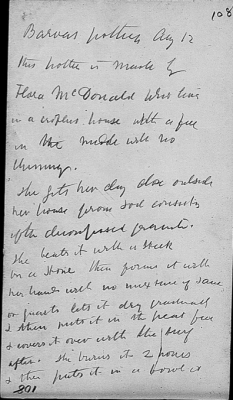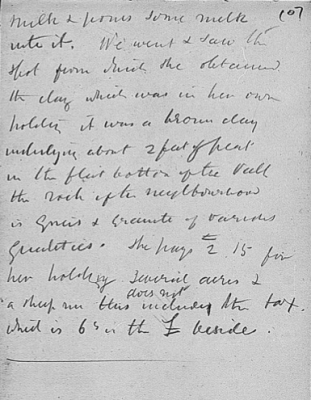To search the RPR site click here
National Archives 39/9 page 81 and 82
This is a transcription of an entry in Pitt-Rivers workbook drawn up whilst he was acting as Inspector of Ancient Monuments. It was an account of pottery-making from Barvas in the Isle of Lewis.
Pitt-Rivers acquired some of this pottery, see Add.9455vol2_p320 /7-11, possibly made by this potter. The account was written in 1885 when Pitt-Rivers is known to have toured the Orkney Islands. His unnamed assistant also gives an account which dates the encounter between potter and Pitt-Rivers:
Wednesday Aug'st 12th
Drove with Genl. and Mrs R. and Mr and Mrs Tylor to Barvas. Visited large standing stone from there also some cottages, and in evening went to see Flora MacDonald (an old woman) make some pottery with blue clay (craggons) Stayed at Barvas all night [National Archives Pitt-Rivers workbook 39/16 page 222]
It is interesting that the Tylors were also present. Pitt-Rivers' account is as follows:
Barvas pottery Aug 12 this potter[y] is made by Flora McDonald who lives in a crofters house with a fire in the middle with no chimney.
She gets her clay close outside her house from soil consisting of the decomposed [illegible] She beats it with a stick or a stone then forms it with her hands with no mixture of same [sic?] or [illegible] lets it dry gradually & then put it in the peat fire & covers it over with the turf after. She burns it 2 hours & then puts it in a bowl of milk & pours some milk into it. We went and saw the spot from which she obtained the clay which was in her own holding it was a brown clay underlying about 2 feet of peat in the flat bottom of the vall[ey] the rock of the neighbourhood is gneis & granite of various qualities. She pays [£] 2 15 [shillings] for her holding several acres & a sheep run thus [insert] does not [end insert] including the tax with his 6 s [shillings] in the £ beside
This potter and pottery (called 'craggans') is described here. The process was described by Arthur Mitchell in his book 'Past and Present [1880]:
... this was usually done by women and in their own homes. This is Mitchell's description of what he saw: "The clay she used underwent no careful or special preparation. She chose the best she could get, and picked out of it the larger stones, leaving the sand and the finer gravel which it contained. With her hands alone she gave to the clay its desired shape. She had no aid from anything of the nature of a potter's wheel. In making the smaller craggans, with narrow necks, she used a stick with a curve on it to give form to the inside. All that her fingers could reach was done with them. Having shaped the craggan, she let it stand for a day to dry, then took it to the fire in the centre of the floor of her hut, filled it with burning peats, and built burning peats all round it. When sufficiently baked, she withdrew it from the fire, emptied the ashes out, and then poured slowly into it and over it about a pint of milk, in order to make it less porous. [copied from here]
The above site concludes of the pottery:
So, the craggans were these simple clay pots; more or less spherical, sometimes decorated with marks made with a small stick, fingernail or finger-tip, hand-thrown without the use of a potter's wheel, fired on the domestic hearth, and bathed in warm milk. The potter first made her circular base and then built up the body in coils of about 1" thick; the craggan could take up to two hours to make.
You can find out much more about this type of pottery and its uses on the website here.
The website also gives more information about the pottery Pitt-Rivers saw, Flora Macdonald:
At least one craggan exists which was made by Fionnghal Bheag (Flora Macdonald) of Barvas in 1877. Mr D. I. Nicolson of Bragar had this made and sent it to a Professor Duns, who lodged it with the National Museums of Scotland. A note goes with it: "By whom made? Widow Flora McDonald. Name place and parish: Barvas in the parish of Barvas. When made? August 1877. How hardened? When dried in the sun put in the fire till red hot, then dipped in milk." (Fionnghal Bheag was a well-known local seer; she is most renowned for having 'seen' when two Nessmen had died in isolation on North Rona, and she walked to Ness to warn their relatives, who ignored her claim).
An account by Kate Wilson about Flora Macdonald states:
John MacDonald, a relative of Flora MacDonald and Mary Murray, recounted that when Flora had made the wares 'she would walk the dozen or so miles to Stornaway, and exchange the half sets for groceries. The tea sets were bought by tourists'. ... Mary MacDonald, Flora’s great grand daughter said of her: 'The way I heard of it in my youth from the people around me and from my father, it was my own great grandmother Flora who was the original potter. She was originally from Dell in Ness but came to live in Park Barvas when she married my great grandfather. Her maiden name was Gillies. She and her daughter Mary started making pottery.They got clay from our own croft just across the stream that runs through it. The clay was very smooth and soft and easy to work with. I heard about them making cups mainly with it. No doubt they made other vessels but I only recall hearing of cups.' She also talks about the ‘baptising of the cups’ which was a big night in the house, 'A big peat fire was prepared in the middle of the floor until the embers were red hot. The cups were placed in the fire until they became red hot. They were then lifted out and placed in a big basin of fresh milk. Seemingly this gave them a bit of a glaze and made them brown in colour. Lots of folk would come in to the house to watch that night.'
There is a description of Flora Macdonald's house on pages 83-86 of the workbook.
Sources
http://culturehebrides.com/archaeology/craggan/
'Barvas Ware: A study of the life and work of the women potters of Barvas, Isle of Lewis, the Outer Hebrides.' Kate Wilson Interpreting Ceramics, issue 10. [available on the web]
AP September 2011






